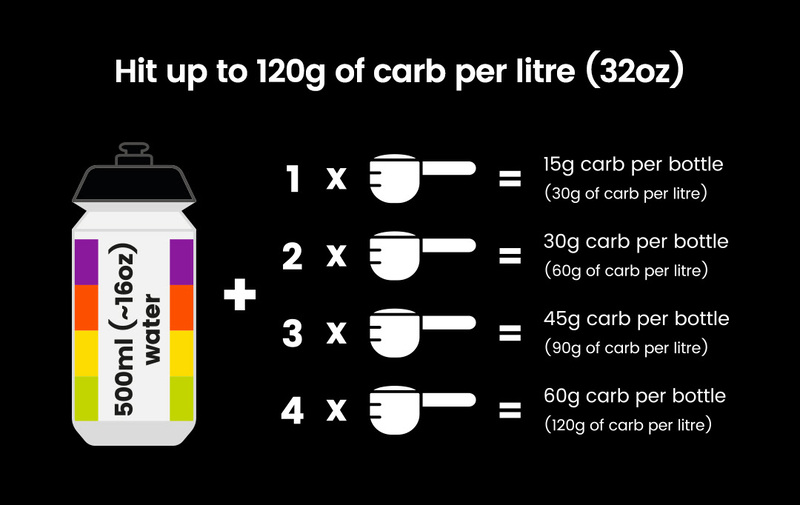We love answering questions from athletes and one of the things we're asked a lot is how staying hydrated should fit into your wider fueling strategy (hence why we rebranded to Precision Fuel & Hydration).
Sports Scientist Andy has written a blog to answer a question that dropped into the hello@pfandh.com inbox...
Should you combine your carb and electrolyte drinks?
Q: "You recommend separating out my fueling and hydration strategies, but can I carry a bottle of carbs and a bottle of electrolytes and switch between the two?"
A: It's a good question and you’re right that we do generally recommend decoupling fueling and hydration for longer endurance events, but the science behind why is not a closed book. Sometimes, different strategies end up working for different people (or even for the same people in different conditions).
It’s important to start by saying that the aim is to find a strategy that works FOR YOU, so that should be your focus.
What works for you as an individual isn't something that can be figured out entirely theoretically, so this will require a decent amount of trial and error during training. Be prepared to try some stuff and to make a few mistakes in order to get to the bottom of your individual case.
The reason we've typically suggested getting your carbohydrates from solid fuel sources, such as gels, chews, bars and real foods, is that this approach results in less overall GI distress for athletes who are relatively inexperienced when it comes to refining a fueling and hydration strategy, especially in the heat or during longer events.
Keeping your hydration and fueling separate enables you to adjust the amount of fluids you take on (which will be highly variable and based primarily on sweat output in the conditions) separately to the amount of carbs you ingest (which is much more ‘fixed’ based on how much carb you aim to consume per hour).
So, if you're thirsty you can take a drink without taking on extra carbs. If you're hungry, you can consume a gel or a chew without the need to take on more fluids.
Furthermore, a problem with taking everything in liquid form is that it can potentially rush into the gut too fast and overwhelm the intestines' capacity to absorb what you're throwing at it. This can lead to discomfort, bloating and even sickness or diarrhoea in some cases.
This is especially true in hot conditions when blood flow to the gut is compromised because you sweat a lot (thus reducing blood volume) and more blood has to go to the skin to help to cool you down. (It might be less of an issue in colder conditions when there's less overall competition for blood flow, so digestion and absorption occurs more easily in such conditions).
We also think that it's highly relevant that your body naturally tends to crave fluids when you eat food in an attempt to aid digestion (how often do you sit down and eat a normal meal without taking a drink?).
Therefore, when you do take most of your carbs via something quite solid, you normally get a craving for fluids with it, which is your body's way of trying to balance out the consistency of what you've just ingested in your stomach.
This instinct helps you to drink appropriately based on what your body needs to aid digestion, as well as to maintain hydration status.
The end result of this is a more optimal mix in the stomach and a happier gut overall when compared to drinking a super-concentrated mix in a single bottle.
That said, our Athlete Case Studies have shown that a growing number of elite and professional athletes are combining their carbs and electrolytes in one bottle. It's something that they've practised in training over a significant period of time, and led to the launch of...
PF Carb & Electrolyte Drink Mix
To help athletes who are keen to get their fluids, electrolytes and carb from one bottle, we introduced the PF Carb & Electrolyte Drink Mix to our range of products for athletes who are taking part in events with high intensity efforts that last ~1-2 hours.
The PF Carb & Electrolyte Drink Mix delivers the critical trifecta of carbs (60g per litre), fluids and electrolytes (1,000mg per litre) for high intensity efforts, although it can also be a useful contributor to your energy needs during longer sessions.
It delivers a steady stream of rapidly digestible energy along with fluid and a significant level of sodium to combat dehydration and electrolyte losses.
We then started working with pro tour cycling team, Lotto Dstny, and they were after even greater flexibility from their bottles...
PF Carb Only Drink Mix
We agreed to collaborate to develop a product with Lotto Dstny that'd give the team even more flexibility when it comes to nailing their race nutrition strategies.
Which is why we added the PF Carb Only Drink Mix to our product range...
The Carb Only Drink Mix is an important part of my race nutrition strategy, providing me with the flexibility I need to hit my numbers in lots of different race scenarios.
On hot days, I drink 3 bottles an hour early on, so it's useful to be able to go "Carb Only" with the third bidon to hit 110-120 grams per hour without taking in more sodium than I need.
Victor Campenaerts, Most Combative Rider at the 2023 Tour de France

The PF Carb Only Drink Mix provides a more flexible way for you to hit your numbers.
I can hear you asking, "wait, how do I get my sodium on board in order to nail my hydration as well?".
If you need to get some sodium on board as well, you could consider the following...
3 ways to hit your sodium numbers when using Carb Only Drink Mix
- Add your low-cal Precision Hydration tablets to your Carb Only Drink Mix
- Chase down some Electrolyte Capsules with your drink mix
- Alternate between bottles of Carb Only Drink Mix and our rechristened Carb & Electrolyte Drink Mix
Ultimately, it will be a case of using some trial and error during training to work out a hydration and fueling strategy that's best suited to you and the event you're training for.
If you have any questions about how to hit your numbers and nail your fuel and hydration strategy, book a free one-to-one video call with our Athlete Support Team.
